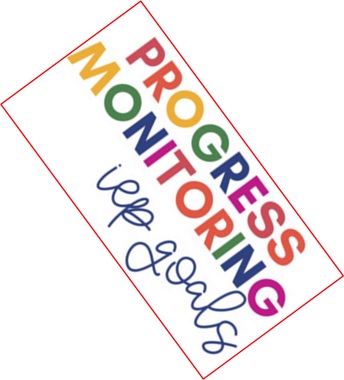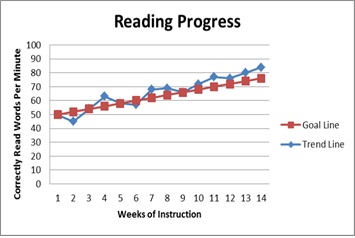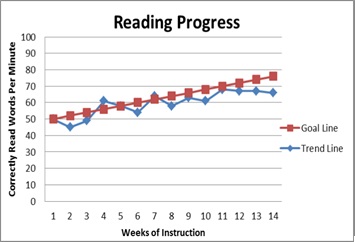Related Products
For Professionals
- Amplification
- Assessment of Student Skills, Challenges, Needs
- Early Childhood: Infants, Toddlers, Preschool
- Hearing Loss – Identification, Impact and Next Steps
- IDEA Law Summary Information
- Language and Speech Development Issues
- Legal Issues in Serving Children with Hearing Loss
- Listening (Auditory Skills) Development
- Planning to Meet Student Needs
- Self-Advocacy Skills for Students with Hearing Loss
- Self-Concept: How the Child with Hearing Loss Sees Himself
- Social Skills
- Speech Perception & Learning
Related Teacher Tools Takeout Items
Progress Monitoring, What’s the Point?
 The systematic process of collecting data on an IEP goal is used to assess a student’s performance academically, behaviorally, and functionally, is called progress monitoring. Progress monitoring helps teachers and IEP teams determine if a student’s individualized education planning is effective for promoting growth and progression of skills. The information collected helps guide instruction and reveals areas where instruction needs to be adjusted. Progress monitoring and reporting are not the same. When it’s time to report the student’s progress, the teacher must gather the data and report the progress in a way that mirrors the goal on the student’s IEP.
The systematic process of collecting data on an IEP goal is used to assess a student’s performance academically, behaviorally, and functionally, is called progress monitoring. Progress monitoring helps teachers and IEP teams determine if a student’s individualized education planning is effective for promoting growth and progression of skills. The information collected helps guide instruction and reveals areas where instruction needs to be adjusted. Progress monitoring and reporting are not the same. When it’s time to report the student’s progress, the teacher must gather the data and report the progress in a way that mirrors the goal on the student’s IEP.
When a student is found eligible for special education, they are introduced to supports and services that attempt to make educational programming equal to that received by typically developing and typically hearing students. In order to do this, comprehensive assessment is conducted to find the student’s strengths and weaknesses and address gaps in academic and functional achievement. Assessment for eligibility is different from assessment for progress monitoring, and it is also different from screening. Eligibility assessment is conducted by a multidisciplinary team and looks to establish areas in which the student needs additional targeted instruction in order to make progress, due to a qualifying disability. Once these areas are established, skill deficits are addressed by either a SMART goal, accommodation/modification, or a related service. Goals are then measured, in intervals, and reported periodically to the parents/guardians. Progress monitoring is the systematic process of collecting data on an IEP goal is used to assess a student’s performance academically, behaviorally, and functionally.
 What are the benefits of progress monitoring?
What are the benefits of progress monitoring?
- Documents student progress (or lack of it)
- Informs decisions about how students can be more effectively instructed
- Leads to more appropriate and effective instruction
- Supports better communication between educators and parents about the student’s progress
Why is progress monitoring necessary?
The Individuals with Disabilities Education Act (IDEA) requires school districts to provide parents/guardians progress reports for students receiving special education, as often as schools provide regular progress reports to parents of students without IEPs. IEP goals are evaluated, and the IEP Team determines whether the child is making progress toward IEP goals. IEP Teams should use the periodic progress reporting to inform parents of their child’s progress. Parents and other IEP Team members should collaborate and partner to track progress appropriate to the child’s circumstances.
Progress monitoring and reporting aren’t the same.
Monitoring a student’s progress is done every time a student and teacher are together. Teachers monitor progress through observation, formative assessment, tally sheets, informal practice activities, and other informal ways to gain insight to whether the student is making progress. Anecdotal notes are another way to document a teacher’s observation of skill development. When it’s time to report the student’s progress, the teacher must gather the data and report the progress in a way that mirrors the goal on the student’s IEP. For example, if a student was assessed and found to have skill deficits in the areas of auditory skill development, then a possible measurable annual goal could be:
“After being read a story with 6-8 sentences, increasing in length and complexity to 12-14 sentences, TSW will be able to organize events in the story, with 80% accuracy from a baseline of 40%, in 3 consecutive trials, as assessed triweekly.”
|
Monitoring might include observations, tallies, class participation, thumbs up/thumbs down etc., but the report must mirror the criteria as written in the goal. |
Reports of progress should include percentages and number of trials, as well as how the student was assessed for skill development (teacher made tests and quizzes, teacher observation of skill, etc.). It’s confusing to the parents/guardians when a teacher reports progress but it’s not written in a way to make it clear how the student’s current progress compares to how the student was doing at the time of evaluation. Using the goal above as an example, the teacher should report progress as a percentage, for each trial given during the progress monitoring interval, and should include the likelihood for the student to reach their goal in one annual school year.
Steps for progress monitoring student goals:
- Determine the student’s current level of performance
- Identify goals that will take place over time
- Measure the student’s performance on a regular basis
- Compare the expected progress to actual student performance
- Consider changes to instruction or services when student progress toward goals is either not being made or the goal has been met

How often will data be collected for each goal?
|
One of the biggest mistakes teachers make is not allowing enough time for delivering new instruction, providing ample practice time for skill development, and giving the student enough time to make progress after systematic instruction is provided. There must be enough data points to compare to baseline scores to show valid results that indicate if the strategies used are working for the student. |
Data collection for progress monitoring depends on how often a student is seen for instruction. If a student is seen daily, or weekly, then data collection can occur more often than a student who is seen biweekly or monthly. Teachers use baseline scores to create realistic mastery level scores, which creates a goal line that shows the trajectory for progress to be made in intervals. When the trend line doesn’t show progress or shows inconsistent progress, then teachers can adjust instructional approaches to meet the students’ needs.
Graphing data points
Here are two sample graphs to illustrate what graphed data points look like. Seven to twelve data points are needed to make statistically valid instructional decisions. Data must be collected regularly and frequently in order to have sufficient data points to make valid decisions.
 Figure 1: Shows a trend line above the goal line. This indicates the student is making better than expected progress. The IEP team may want to consider setting a more challenging goal.
Figure 1: Shows a trend line above the goal line. This indicates the student is making better than expected progress. The IEP team may want to consider setting a more challenging goal.
 Figure 2: Shows a trend line below the goal line. This indicates the student is not making progress as expected. The IEP team should consider whether an instructional change is needed to address the student’s lack of progress.
Figure 2: Shows a trend line below the goal line. This indicates the student is not making progress as expected. The IEP team should consider whether an instructional change is needed to address the student’s lack of progress.
What if the trend line shows inadequate progress, in light of the student’s circumstances?
If a teacher is monitoring a student’s progress each session, through informal assessment like accuracy of student responses to questions, teacher observation, tally marking frequency of behaviors etc., then most often a teacher will be able to see if a strategy is working with a student. Sometimes, when a teacher graphs a student’s scores, they will see that the trend line isn’t measuring up to the trajectory line. Teachers should then adjust techniques and provide strategies that help the student move towards mastery.
In summary, teachers use progress monitoring to help gauge the effectiveness of a student’s programming and gain insight if the student is making adequate progress towards IEP goals. If the student’s progress is limited or seems to be progressing slower than expected, then monitoring information can help teachers gauge instructional practices and modify as necessary. Progress Monitoring is both legally necessary to meet compliance and practically necessary to ensure students are progressing towards their goals.
References:
Progress monitoring for IEP goals. What is an example of progress monitoring? Retrieved October 20, 2022, from
https://www.askresource.org/resources/progress-monitoring#:~:text=Steps%20for%20progress%20monitoring%20student,progress%20to%20actual%20student%20performance
Monitoring Progress – Wisconsin Department of Public Instruction. Wisconsin Department of Public Education. (n.d.). Retrieved October 17, 2022, from https://dpi.wi.gov/sites/default/files/imce/sped/pdf/monitoring-progress-iep-checklist.pdf
Author: Michelle Andros
